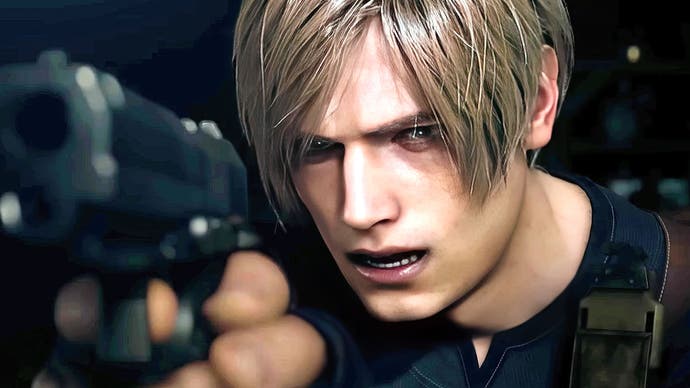Resident Evil 4 remake: do technical troubles doom a would-be classic?
Digital Foundry investigates the Chainsaw Demo on Series X, PS5, PS4 and PC.
The Resident Evil 4 Chainsaw Demo is here ahead of the release of the full remake, and we thought it would be fun to let DF tech specialists Alex Battaglia and John Linneman loose inside the game to see what they made of it. Consider this a mini DF tech review then, a first look to tee up our full coverage - expected sometime around the release of the full game on March 24th.
There's already plenty to see here, with the demo's release on current-gen consoles, last-gen consoles and PC providing answers as to visual quality, RT settings, performance and more - albeit with the proviso that we can't confirm our findings before the full game, and most likely a launch-day patch, is available for testing.
Let's start with the basics. There are two modes available on each console, a frame-rate mode and a resolution mode, which is fairly standard - but there are also graphical options within each mode that can further affect performance and image quality. This is very cool, as you don't often get these kinds of PC-style settings on console, but based on our initial findings these settings may not be working as intended.
For example, you can turn on geometric hair strands to replace the 2D hair normally present in the game - but based on the results of the demo, this is worth keeping off, with questionable results on PS5 and Xbox Series X. Ray tracing is also, sadly, of middling quality on the new premium consoles. The ray-traced global illumination (RTGI) of past RE titles has disappeared in favour of classic screen-space ambient occlusion (SSAO), with reflections being the only noticeable RT effect. PC players see the most reflections, which is fairly standard, but there's also a curious difference between PS5 and Xbox Series X, where the PlayStation version appears to be lacking some reflections found in the Xbox version. Hopefully this is a bug that will be fixed for launch, as both consoles ought to be roughly equivalent in RT capabilities.
Returning to the standard presentation of the game then, resolution mode appears to be using a 4K checkerboard as we've seen in prior RE entries on current-gen machines. There's plenty of post-processing which makes exact pixel counts challenging, but by eye we can say that Xbox Series X has a largely 4K-like presentation, with a slightly softer image on PS5 that looks to be using a lower internal resolution.
Weirdly, enabling the chromatic aberration (CA) setting makes the PS5 version look even lower resolution, whereas on Xbox Series X it affects clarity without the same deleterious effect to image quality. Even with CA disabled though, the PS5 version exhibits greater pixel crawl, a softer image and more break-up. It's not clear why the PS5 version is in this kind of a state, but again its image quality treatment needs to be fixed for launch.
Frame-rate mode prioritises performance and therefore responsiveness with a cut to resolution; we measured around a 1728p to 1800p checkerboard on Xbox Series X and 1440p to 1800p checkerboard on PS5 in different scenes. This could suggest a dynamic resolution system, but as mentioned earlier the heavy postprocessing (and the game's TAA) makes it hard to get an exact pixel count. Ultimately, the resultant image is what matters, and both consoles exhibit noticeably sub-4K image quality with a softer presentation and more break-up in vegetation on PS5 in this mode.
Thankfully, the performance and frame-rate modes do have an effect on performance (unlike the paradoxical Wo Long: Fallen Dynasty). Resolution mode offers a sub-60fps experience suitable for users with VRR-capable displays, regardless of RT or geometric hair strands being enabled or disabled. Frame-rate mode, conversely, offers a locked 60fps on PS5 and Series X, but enabling the RT or hair strands options does make frame-rate drops possible, so it's up to you to decide whether the extra eye-candy is worthwhile. Based on the demo, we'd suggest leaving both off, but there's still the possibility that these will be more meaningful additions in the final game.
The PlayStation 4 version of the game actually stands up surprisingly well in head-to-head comparison with the next-gen versions, and genuinely looks like one of the best games we've seen for the console. However, there have been cutbacks here - including a 900p internal resolution with TAA, drastically lower texture resolution in many spots, missing real-time shadows in many scenes, no subsurface scattering on characters and worse environmental lighting. Despite all of this, the only real complaint we have regarding the game is its frame-rate, which is unlocked and can hit 60fps but normally ricochets between 40 and 50fps. An optional 30fps frame-rate cap would provide more predictable performance, and hopefully this could be added to shore up what is otherwise a perfectly playable experience.
PC users can benefit from better performance and image quality than on console, with hair and texture quality being noticeably improved. RT is a bit better, with more objects shown in reflections, while SSAO has fewer errors but perhaps looks a tad oversharpened with TAA working differently that it does on consoles. The game runs smoothly, but there do appear to be small loading stutters - most noticeable when running above 60fps. Overall, PC looks like the best platform to play the Resident Evil 4 remake at present, but we'll have to wait for the full game to know for sure.
And with our taste-test complete, that's the current state of play for Resident Evil 4 based on the Chainsaw Demo. PS5 exhibits several technical issues that detract from what is otherwise a promising port, although Series X does have issues of its own - with noticeably weightier controls that detract from what would otherwise be the clearly better version of the game versus PS5. PS4 is in a solid position, only lacking an optional 30fps cap for a more stable presentation. PC is the obvious choice if your hardware is up to the test, with easier aiming thanks to the mouse, excellent image quality and none of the PS5's peculiarities, and only minor traversal stutter that's only noticeable at 120fps. So no platform is perfect, but then again we've yet to test the final code so we'll see how it goes.
There's good potential here, for sure. The original game is a series favourite for many, and I'll certainly never forget the iconic 'what're you buying, stranger?', so I hope that Capcom is able to ensure it arrives on PC and console in a more polished state than the current demo. There's still plenty to appreciate here, with what looks like a promising remake in terms of graphics and gameplay, but these technical wobbles need to be ironed out.










